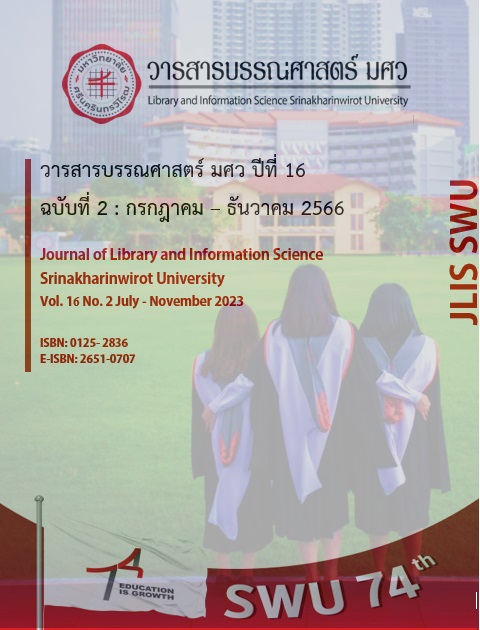Factors Affecting Ramkhamhaeng University Students’ Technology Adoption Behaviors on Google Classroom Platform Used in Online Learning and Teaching: A Case Study of Subject Information and Technology for Searching and Using the Library
Keywords:
Google Classroom, least effort, technology acceptance, perceived convenience, perceived ease of useAbstract
The research objectives were to: 1) study factors affecting technology adoption behaviors on the Google Classroom platform for online learning and teaching; 2) test co-variance factors that can describe technology adoption behaviors on the Google Classroom platform for online learning and teaching; and 3) propose a pilot model of technology adoption behavior on the Google Classroom platform for online learning and teaching. The samples for this research were 378 students selected through stratified random sampling. Data were collected by online questionnaires and analyzed by frequency, percentage, average, standard deviation, and regression analysis to test hypotheses which determined the level of statistical significance of .05.
The research results found that: 1) Ramkhamhaeng University students’ online learning and teaching by Google Classroom revealed that perceived usefulness and perceived ease of use were more important than perceived convenience and intention to use adoption behaviors on the Google Classroom platform; 2) Results of testing research hypotheses showed that four variables consisting of (1) perceived usefulness, (2) perceived convenience, (3) perceived ease of use, and (4) intention to use can describe the total co-variance up to 70% of Google Classroom adoption behavior on the online study at a level of statistical significance of .05.; and 3) Obtained a pilot model of behavior accepting the Google Classroom platform for online teaching.
References
Alassafi, M. O. (2022). E-learning intention material using TAM: A case study. Materials Today: Proceedings, 61, 873-877.
Alqahtani, A. (2019). Usability Testing of Google Cloud Applications: Students' Perspective. Journal of Technology and Science Education, 9(3), 326-339.
BBC News Thai. (2020). Covid-19 : Chronology of events, map, infographic, Total number of infections and deaths in Thailand and around the World. https://www.bbc.com/thai/thailand-52090088 (In Thai)
Davis, F.D. (1989). Perceived usefulness, perceived ease of use, and user acceptance of information technology. MIS Quarterly, 3, 319.
Er, E., Kopcha, T. J., Orey, M., & Dustman, W. (2015). Exploring college students’ online help-seeking behavior in a flipped classroom with a web-based help-seeking tool. Australasian Journal of Educational Technology, 31(5).
Fauzi, A., Wandira, R., Sepri, D., & Hafid, A. (2021). Exploring students' acceptance of Google Classroom during the covid-19 pandemic by using the technology acceptance model in West Sumatera Universities. Electronic Journal of e-Learning, 19(4), pp233-240.
Hidayah, N., & Fernanda, J. (2021). Analisis Penerimaan Aplikasi Pembelajaran Online Menggunakan Technology Acceptance Model 3 dan Partial Least Square Structural Equation Model (PLS-SEM). Journal Focus Action of Research Mathematic (Factor M), 3(2), 161–172. https://doi.org/10.30762/factor_m.v3i2.3097
Mooers, C. N. (1960). Mooers’ Law: Or, why some retrieval systems are used and others are not (Editorial). American Documentation, 11(3), ii, 204.
Huang, T.-H., Liu, F., Chen, L.-C., & Tsai, C.-C. (2021). The acceptance and impact of Google Classroom integrating into a clinical pathology course for nursing students: A technology acceptance model approach. PLoS ONE, 16(3), 1–16. https://doi.org/10.1371/journal.pone.0247819
Jansen, B. J., Spink, A., Bateman, J., & Saracevic, T. (1998, April). Real life information retrieval: A study of user queries on the web. In Acm sigir forum (Vol. 32, No. 1, pp. 5-17). New York, NY, USA: ACM.
Junan, R. D. (2021). The Effect of The Use Google Classroom on The Learning Effectiveness Students in FKIP Simalungun University in The Covid-19 Pandemic. Jurnal Scientia, 10(1), 22-26.
Kanuka, H. (2011). Interaction and the online distance classroom: Do instructional methods effect the quality of interaction. Journal of computing in higher education, 23(2), 143-156.
Liya, A. D. W. (2021). The effect of Google Classroom in Blended Learning on university students’ English ability. J-SHMIC: Journal of English for Academic, 8(1).
Mann, T. (1993). Library research model: A guide to classification, cataloging, and computer. New York: Oxford University Press.
Rukmana, G. W. (2021). Students’ Perception toward the Use of Google Classroom as Teaching and Learning English Media for EFL Students. Journal of Educational Study, 1(3), 191-199.
Santos, J. M. (2021). Google Classroom: Beyond the Traditional Setting. Problems of Education in the 21st Century, 79(4), 626-639.
Spector, P. E. (1992). Summated rating scale construction: An introduction. Newbury Park, CA: Sage.
Susanto, E., Sasongko, R. N., & Kristiawan, M. (2021). Constraints of online learning using Google Classroom during covid-19. Education Quarterly Reviews, 4(2).
Wijaya, A. (2016, February). Analysis of factors affecting the use of Google Classroom to support lectures. In The 5th International Conference on Information Technology and Engineering Application (ICIBA2016). Bina Darma University.
Yamane, T. (1970). Statistic: Introductory analysis (2nd ed.). New York: Harper & Row.
Zipf, G. K. (1949). Human behavior and the principle of least effort: An introduction to human ecology. New York: Hafner.
Additional Files
Published
Issue
Section
License
Copyright (c) 2023 Faculty of Humanities, Srinakharinwirot University

This work is licensed under a Creative Commons Attribution-NonCommercial-NoDerivatives 4.0 International License.
Copyright Notice
Copyright of articles in the journal of Journal of Library and Information Science Srinakharinwirot University is the author's and the Faculty of Humanities, Srinakharinwirot University. All articles submitted for publication will be assessed by a group of distinguished reviewers. The Faculty of Humanities, Srinakharinwirot University and the editorial board claim no responsibility for the contents or views expressed by the authors of Individual articles. Copying is allowed freely, provided acknowledgement is made thereof, and within the scope of copyright law.



